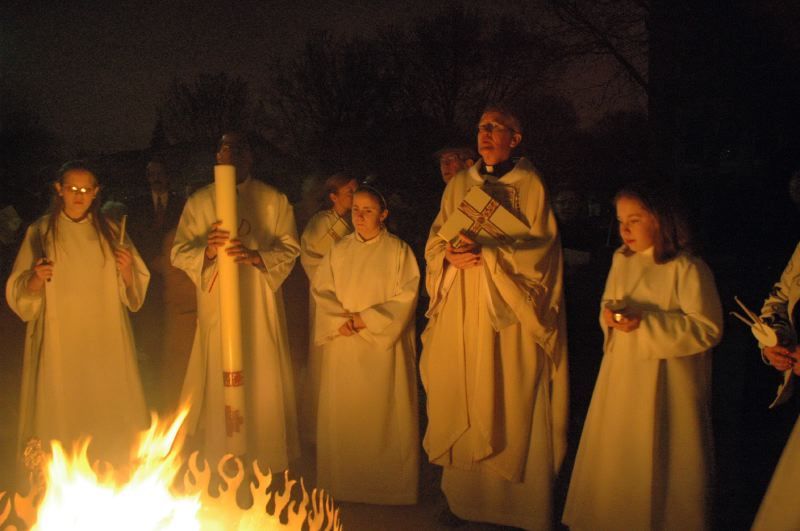
Today’s hymn choice from Sing Praise is “This is the night of new beginnings” by Bernadette Farrell. The tune and the words of the chorus are the same as her hymn “Longing for light”. At first I thought the present hymn an adaptation of that one, but see John’s comment below, that this hymn dates from 1990 & 1991, and “Longing for light” is later (1993).
These original words, then, are intended for the Easter vigil. This ceremony is observed by some, but by no means all, church congregations, either at sunset on Easter eve or sunrise on Easter morning depending on local preference). Neither is ‘wrong’, for who can say at what moment Christ was resurrected between the start of the Sabbath (Friday evening) when the women went home and the rising of the sun on Easter Sunday when they returned? The emphasis varies with the chosen time: if at sunset, it’s about entering the darkness, the loss of contact with God as Jesus his son has died (while also anticipating the resurrection). We do need this in our spiritual lives, an acknowledgement that sometimes God seems absent and life seems hopeless, and faith in the resurrection seems a distant hope.
If the vigil takes place around sunrise, it begins in sombre darkness, often gathered around a fire, but as the day dawns the Easter candle is lit from the fire and carried into church with great shouts of “The light of Christ!” and “Alleluia, Christ is risen!”
This year, of course, it was all different. At our church at least, the Covid restrictions meant there was no singing other than the Vicar’s wife singing an Easter song quietly outside the church, and a strong wind meant that the Easter candle had to be lit indoors (there was no fire anyway: our service is not at dawn).
But back to the words of the hymn. Both options above seem to be covered: verse 1 speaks of the “night of new beginnings” (a reminder to me of an Easter sermon by the late Revd Val Clarke who described the Christian life lived in the light of the Resurrection as “the land of Begin-Again”). Verse 2 is about the “night Christ our Redeemer rose from the grave triumphant and free”. The middle verse speaks of the fire kindled in darkness to dispel the shadows of night.
Verse 4, which should probably be marked with an increase in volume and maybe tempo, urges people to “Sing of the hope deeper than dying, sing of the power stronger than death, sing of the love endless as heaven, dawning throughout the earth”. I love those words: it reminds us that the Easter celebration is not for the individual, nor just the local congregation nor even the totality of Christians worldwide, a billion strong though we are. No, Easter is for the whole of creation to sing praise to our redeeming God.
Finally, as the sun rises perhaps, the last verse proclaims that “into this world morning is breaking” and calls God’s people to “lift up your voice, cry out with joy, tell out the story, all of the earth rejoice!”
The chorus after each verse is “Christ be our light, shine in our hearts, shine through the darkness. Christ be our light, shine in your church gathered today”. This is another reminder that we are part of a larger whole.
At first I thought Stephen must be right that this hymn is an adaptation of Bernadette Farrell’s “Longing for light” (no. 13 in the book, set for “Advent”), with words set for the Easter Vigil; but now I doubt it, because the dates of the copyright details seem to say the opposite: this hymn dates from 1990 & 1991, and “Longing for light” from 1993.
I found this hymn less convincing than “Longing for light”. I think part of my trouble is that the hymn “Longing for light” is a genuine aspiration which can be sung by all Christians everywhere at any time; whereas a phrase like “This is the night” does tie the hymn down to this night in particular. Maybe I’d have been happier singing “That was the night” – seeing as the actual night itself was nearly 2000 years ago.
About when to celebrate the resurrection (at dusk or dawn), I fully accept what Stephen says that “neither is wrong”. But as I mentioned when commenting on “Exult, creation, round God’s throne”, I’ve found it difficult to make an Easter Vigil service work in practical terms; and I am always slightly uneasy that the service can focus on the candle which is lit instead of on the Christ who is raised. Verse 3 is ambiguous – I guess deliberately so. I can manage to sing it provided I keep firmly in mind that Christ is the “fire kindled in darkness” which the verse is referring to, and not the candle.